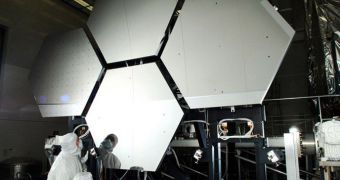Experts at the American space agency say that the launch date for the new James Webb Space Telescope (JWST) could be pushed back a few months. The officials support engineers handling the complex machine, who say that the delay will be caused by the fact that they need to run additional tests on the complex observatory. Billed as the successor of the renowned Hubble Space Telescope, the JWST will be the largest and most advanced space-based instrument of all times. Its observational capabilities will exceed those of all other telescopes out there today, but its major drawback is the fact that it features a wide array of as-of-yet-untested, new technologies.
This is not so bad, experts say, provided that science team get a chance to test these technologies until they are satisfied with the results. Hence the need for extra testing, NASA officials say. But the delay could be even larger, according to the NASA JWST project manager Phil Sabelhaus. He says that an unrelated lack of funding threatens the program as well. If the Congress does not grant the necessary money the next fiscal year, in 2011, then the impressive telescope could be grounded for a much longer time. Sabelhaus adds that the new battery of tests was recommended in a review of the mission-critical JWST design requirements, which took place late last month.
“One of the recommendations is to ask Congress for additional funding in [2011]. But all the factors have to be folded in, including whether it is practical to think we could get funding in [2011]. If that's not the case, you may have to go in and look at further slippage to the launch date,” he told Space. “Given that you can't test this thing full up you need to do some additional testing to prove the margins that you've got are adequate for a successful mission. They like the testing we had [planned], they just think we ought to do more. We're running a little hotter these days in trying to get this thing designed and built. We spent some money over the last few years working off some issues that were hard problems, and we've gotten to the point where we're probably going to need more than we planned on,” he concluded.
JWST will be launched aboard an Ariane 5 delivery system. The rocket will most likely take off from the European Space Agency's (ESA) Kourou Space Center, in French Guiana, South America. It will operate in the 0.6 to 28 micrometer wavelength range, in order to be able to peer through large amounts of cosmic dust and gases. Because it operates in infrared, the entire telescope will have to be cooled down to roughly 40°Kelvin (−233.15°C or −387.67°F).
In order for that to be possible, the observatory will be placed in an extreme orbit around the Sun, in the second Lagrangian point (L2). Basically, its orbit will be a lot further than the Moon, at a distance of about 1.5 million kilometers from Earth. Regularly, celestial bodies that orbit the Sun at a distance greater than our planet accomplish a full rotation around the star in less than a year, but James Webb will be able to do so as fast as our planet, mostly because of the complicated characteristics of its orbit, where the gravity pull from the Sun and the Earth makes for a very steady orbit. This would allow for a minimum fuel consumption in thrusters, and for a designated 10-year lifespan.

 14 DAY TRIAL //
14 DAY TRIAL //